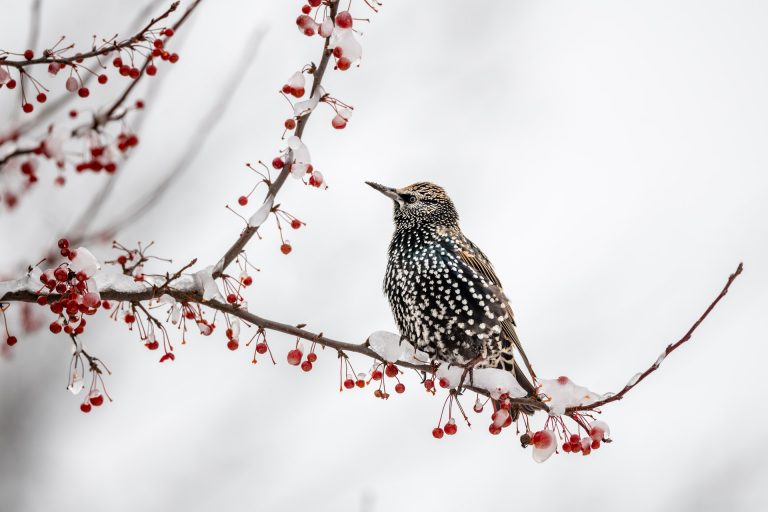In North America, the starling (Sturnus vulgaris), has become a common sight. Native to Europe, Asia and Africa, northern Australia and the tropical Pacific Islands, starlings are medium-sized birds with glossy black feathers that have a metallic sheen and white speckles. This smart and useful songbird has an interesting history.
Some hold that they were originally brought to the US by a Shakespeare fan who wished to have, in America, every bird ever mentioned in Shakespeare’s works. Historians say that they were released intentionally in New York City’s Central Park as a form of pest control. Perhaps it was a combination of both; but regardless of their origins, they are here to stay, with an estimated population of 200 million.
Utility and intelligence
While starlings don’t exactly have a sterling public image and are generally seen as a pest bird, they consume a large number of noxious grubs and caterpillars, like those of the gypsy moth, reducing populations by up to 95%. Because they like to dine in groups, they are often regarded as a serious pest, decimating small fruit crops, and emptying bird feeders in no time. Yet their function as a voracious predator may help even the score.
Starlings are remarkably intelligent and adaptable, and are said to make very sociable, “jolly, and highly entertaining pets.” They are capable of producing an astounding diversity of complex sounds. Blending chirps, warbles, trills, whistles and rattling noises are among their vocal abilities. They’re also famous for imitating the calls of other animals, such as eagles or raptors. Some mimic the noises of cats and machines, and many a pet starling has learned to talk.
Astonishingly, starlings have also proven capable of identifying and eliminating agrammatical patterns. Trainee starlings demonstrated that they could identify such patterns by pushing a lever when they realized that the grammar rules had been violated — a feat that could not be duplicated by trained Tamarin monkeys, according to researchers.
Success
You are now signed up for our newsletter
Success
Check your email to complete sign up
Male starlings are very innovative. When they construct a nest they decorate it with flowers in order to attract a female. They use fresh herbs to deter insects from attacking the nests. When a female is sufficiently pleased by a male’s vocal abilities and appreciates his flower presents, she will swiftly pull off his decorations and complete the nesting process herself. The male is then approved as her mate.
Singing stimulates the brain
Flute or wind instruments are commonly used to describe the sound of this birdsong. Birds tend to sing more often and more loudly in the springtime. Their ‘bouts of song’ last longer during the months leading up to the mating season and demonstrate the health of birds looking for a mate.
Just as singing improves mental function in humans, starlings’ songs also stimulate their brains. Annemie Van der Linden, a Bio-Imaging Lab specialist at the University of Antwerp, and her colleagues conducted a study to determine the specifics of how a bird’s brain changes its neurological structure through the course of a year.
According to their research, birds’ brains undergo major alterations as they increase the amount of time they devote to singing. Furthermore, the changes that take place in the brains of birds have an influence on not just the areas responsible for vocalization, but also the senses of hearing and sight. According to CBS, these changes occur gradually up to the bird’s peak season in spring.
Studies indicate that female starlings produce a more complex song (with fewer rattles) than males and they also sing more than earlier studies had shown. In terms of the changes in the brain structure, female starlings also go through the transition more quickly. Male starlings were found to have sluggish growth in the brain hemisphere that regulates their ability to sing, This is due to the fact that male birds have naturally denser brain lobes associated with singing than female birds.
According to a study published in the journal eLife, “Uncovering a ‘Sensitive Window’ of Multisensory and Motor Neuroplasticity in the Cerebrum and Cerebellum of Male and Female Starlings,” one of the most striking characteristics of the female bird’s brain is the close connection between the two hemispheres of the brain that govern its senses.
Legendary starlings
The ancient Celts regarded starlings as sacred birds. They were esteemed by the Druids, and the Welsh term for starling is “drudwen” or “drudwy.” The Mabinogion tells the story of Branwen, the giant hero-god King Bran’s sister, who was imprisoned and put into service for King Matholwch of Ireland despite bearing him a son. Branwen taught her pet starling to talk and sent him with a message to her brother, who crossed over the water and conquered the Irish, thereby releasing Branwen.
Wolfgang Amadeus Mozart acquired a pet starling in 1784, who soon became his closest friend. When the Starling died, he prepared a eulogy for it since he loved it so much. One of his musical compositions was apparently “rewritten” by the bird, according to his diary entries. Mozart referred to it as a part of the 17th movement of the Piano Concerto in G minor. In his journal, he noted, “That was fine!” after recording the modification.
A cautionary note: While in most of the United States, it is legal to keep starlings in captivity, this is not true in every state and every area. Before adopting a starling or, be sure to check with your state and local regulations, which may override federal law.













